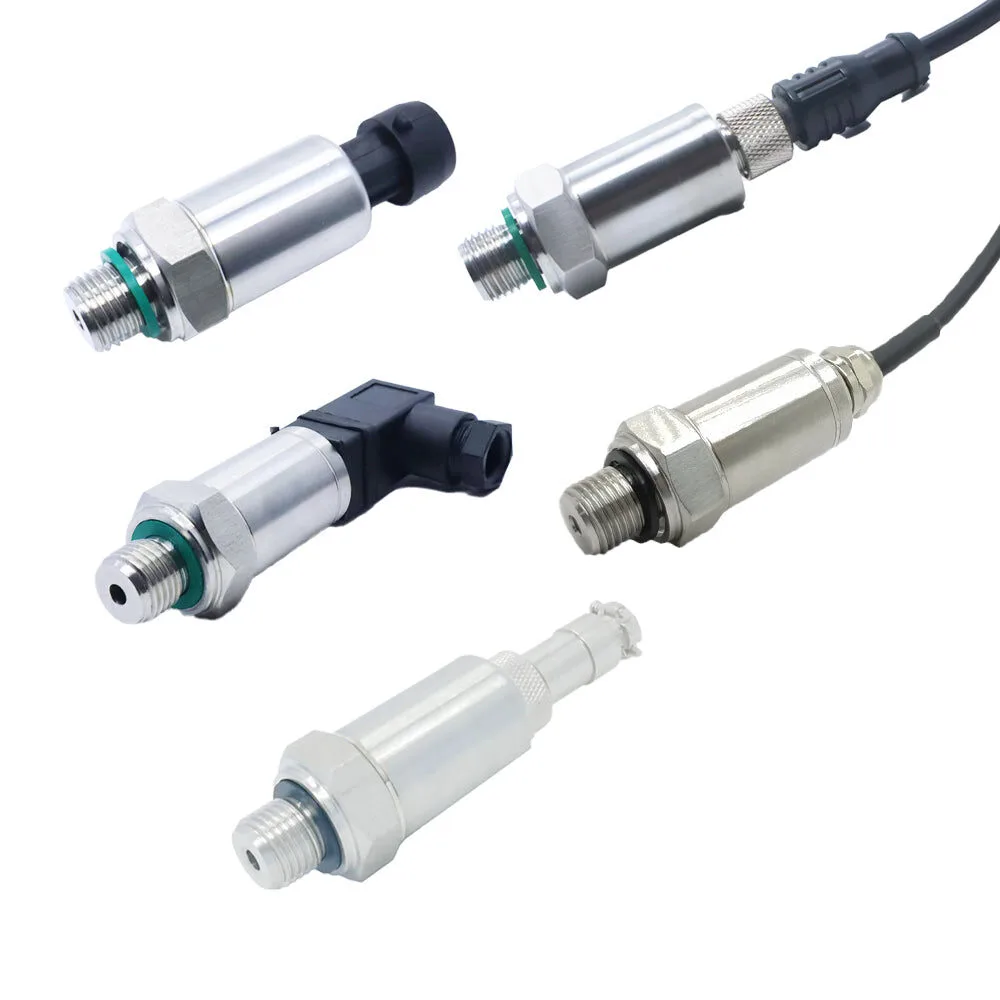
1. Introduction
Hydraulic systems are a core technology in modern industry, essential for transmitting and controlling power in machinery, manufacturing, and energy systems to ensure the proper operation of mechanical equipment. Within these systems, high-performance pressure sensors play a critical role, as they must provide precise and stable pressure monitoring in high-pressure and complex environments. As industrial demands continue to grow, sensor technology has evolved, with ceramic and glass microfused materials emerging as two key sensor core materials.
Ceramic materials are renowned for their high strength, heat resistance, and corrosion resistance, maintaining excellent performance under extreme conditions. They are widely used in demanding industrial applications. On the other hand, glass microfused technology utilizes high-temperature glass powder to create seamless, O-ring-free, highly sealed structures, making it particularly suitable for preventing oil leaks in hydraulic systems. This article will compare the performance of these two materials in hydraulic oil applications, exploring their respective advantages and disadvantages to help readers make the best choice for different application scenarios.
2. Basic Requirements for Sensors in Hydraulic Systems
Pressure sensors in hydraulic systems must meet several key requirements to ensure system safety and efficiency. First, pressure resistance is critical because hydraulic systems often operate under extremely high pressures. Sensors need to function reliably under these high-pressure conditions, preventing performance degradation or failure due to pressure fluctuations.
Second, sealing and oil leakage prevention are particularly important in hydraulic oil applications. Oil leakage not only reduces system efficiency but can also cause equipment damage or safety hazards. Therefore, sensors must have excellent sealing capabilities to effectively prevent hydraulic oil leaks, ensuring the system’s long-term stable operation.
Finally, long-term stability and durability are also essential requirements for sensors in hydraulic systems. Sensors must be able to operate reliably over long periods in high-pressure, high-temperature environments without losing measurement accuracy or failing due to harsh conditions. These basic requirements determine the performance of different sensor materials in hydraulic systems and provide a basis for subsequent material selection.
3. Ceramic Materials in Hydraulic Oil Applications
Material Characteristics: Ceramic is a high-strength, heat-resistant, and corrosion-resistant material that maintains stable performance under extreme conditions. These characteristics make ceramic cores particularly suitable for use in hydraulic oil media, where long-term stable operation is required.

Advantages: Ceramic cores perform exceptionally well under high-pressure and vacuum conditions, especially in terms of long-term stability in extreme environments. Due to the rigidity and durability of ceramic materials, ceramic cores can withstand significant pressure fluctuations without deformation or failure. Additionally, ceramic cores provide accurate and stable measurements even in vacuum conditions, giving them an edge over other materials in certain specialized hydraulic systems. XIDIBEI’s XDB305 series leverages these characteristics of ceramic materials, making it widely applicable in complex industrial environments.
Disadvantages: Despite their excellent performance in high-temperature and high-pressure environments, ceramic cores may not seal as well in hydraulic oil media as glass microfused cores. This is primarily because ceramic materials are relatively hard, making it difficult to achieve the tight seals that glass microfused technology can provide. This means that in some cases, ceramic cores may pose a risk of hydraulic oil leakage, particularly after prolonged use when sealing performance may degrade. This shortcoming makes ceramic cores potentially less suitable for applications with extremely high sealing requirements compared to glass microfused cores. Additionally, ceramic cores are more appropriate for low-pressure environments (≤600 bar) and are not suitable for high-pressure conditions.
4. Glass Microfused Materials in Hydraulic Oil Applications
Material Characteristics: Glass microfused technology is a process that uses high-temperature glass powder to create a seamless and highly sealed structure. This technology is particularly suitable for hydraulic oil media because it effectively prevents fluid leaks. This characteristic of glass microfused cores makes them highly effective in applications requiring a high degree of sealing, especially in high-pressure hydraulic systems.

Advantages: The main advantage of glass microfused cores in hydraulic oil media is their excellent sealing ability. The absence of O-rings eliminates the potential leakage risks associated with traditional sealing methods, making glass microfused cores particularly effective in preventing oil leaks. XIDIBEI’s XDB317 series, based on this technology, can maintain sealing integrity over long periods in hydraulic oil systems, reducing system failures due to leakage. This feature makes them an ideal choice for preventing oil leaks in hydraulic systems.
Disadvantages: However, glass microfused cores have certain limitations when dealing with vacuum environments. Due to design and material characteristics, glass microfused cores cannot provide the same level of stability and accuracy in vacuum conditions as ceramic cores. This limits their applicability in some specialized applications, such as complex hydraulic systems that require handling both positive and negative pressures. In these scenarios, glass microfused cores may not meet all measurement needs.
By conducting a detailed analysis of these two materials’ applications in hydraulic oil media, readers can better understand their respective application scenarios and performance characteristics, providing strong support for selecting the appropriate sensor technology.
5. Comparative Analysis and Application Scenarios
Comparative Analysis: In hydraulic oil media, ceramic and glass microfused cores each have different strengths and weaknesses. Ceramic cores excel in pressure resistance and long-term stability in extreme environments. They perform particularly well under vacuum and high-temperature conditions, maintaining high measurement accuracy and resisting external environmental interference. However, due to material characteristics, ceramic cores may not seal as effectively as glass microfused cores, potentially leading to leakage issues in hydraulic oil applications. Therefore, in summary, ceramic cores are suitable for low-pressure applications (≤600 bar), while for high-pressure scenarios (up to 3500 bar), glass microfused sensors are recommended.
In contrast, the strength of glass microfused cores lies in their high sealing ability, making them particularly effective at preventing hydraulic oil leaks. The O-ring-free design not only enhances the overall reliability of the sensor but also reduces potential failures due to seal degradation. However, glass microfused cores are relatively weaker in vacuum environments and cannot offer the same stability in measurements as ceramic cores.
Application Scenario Recommendations: When selecting the appropriate sensor, it is essential to balance specific application needs. If the hydraulic system requires high sealing and oil leakage prevention, glass microfused cores are an ideal choice, especially in positive pressure environments and systems requiring long-term stable sealing, such as pumping stations and water treatment systems. On the other hand, for systems that need to handle both positive and negative pressures or operate under extreme temperature and pressure conditions, ceramic cores may be more suitable, offering higher measurement accuracy and stability under these demanding conditions.
6. Conclusion
In conclusion, ceramic and glass microfused cores each have their unique advantages and suitable applications. Ceramic cores, with their excellent pressure resistance and stability in extreme environments, perform outstandingly in systems requiring complex pressure handling. In contrast, glass microfused cores, with their superior sealing and oil leakage prevention, dominate in hydraulic systems requiring high sealing integrity.
Selecting the appropriate sensor material is crucial for ensuring the long life and high reliability of hydraulic systems. By choosing the most suitable sensor technology based on the system’s specific needs, it is possible to enhance system efficiency, reduce the risk of failures, and ensure safe and stable operation under various conditions. This approach not only improves production efficiency but also reduces maintenance costs and extends the equipment’s lifespan.
